

 The Accurate Reloading Forums
The Accurate Reloading Forums  THE ACCURATE RELOADING.COM FORUMS
THE ACCURATE RELOADING.COM FORUMS  Other Topics
Other Topics  Knives and Knife Making
Knives and Knife Making  Made a knife
Made a knifeGo  | New  | Find  | Notify  | Tools  | Reply  |  |
| one of us |
Gentlemen I made this knife from a J.A. Henckel Sushi kitchen knife. I do not know what it is for. 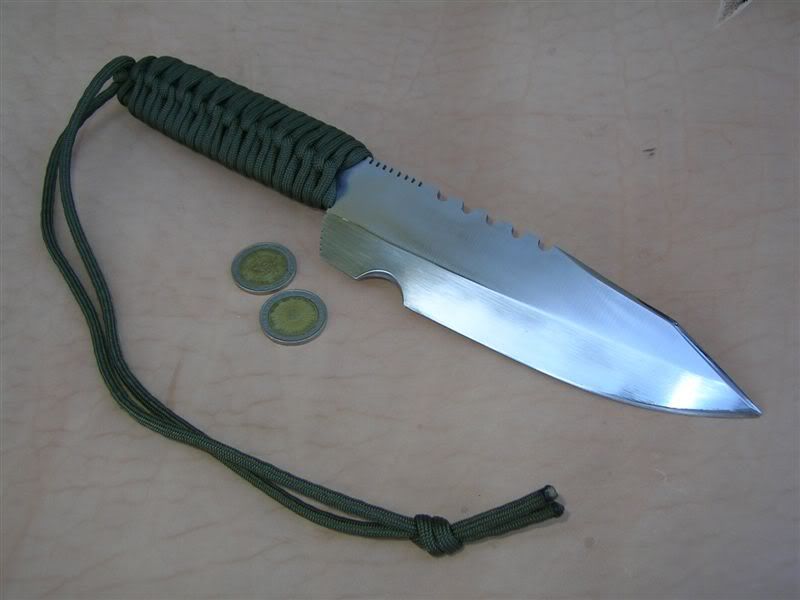 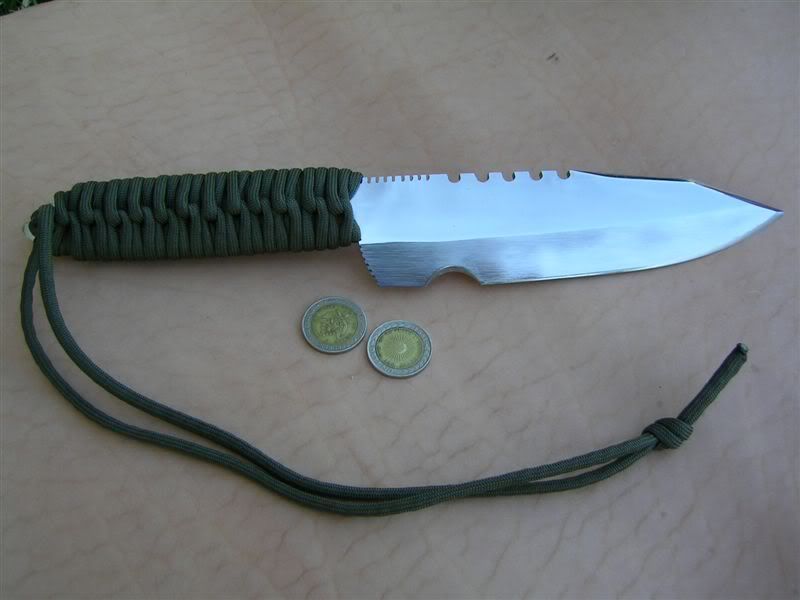 Cheers, André Always always use enough... GUN & KNIFE | ||
|
| one of us |
Who needs a need? I told myself I was going to save $$$ on buying high end knives. I'm several hundred dollars into knifemaking, have 4 blades in various conditions of manufacture, and haven't completed one yet... Have fun! Believe nothing, no matter where you read it, or who said it, unless it agrees with your own reason and your own common sense. | |||
|
| one of us |
we must prove it hunting boars.juan www.huntinginargentina.com.ar FULL PROFESSIONAL MEMBER OF IPHA INTERNATIONAL PROFESSIONAL HUNTERS ASOCIATION . DSC PROFESSIONAL MEMBER DRSS--SCI NRA IDPA IPSC-FAT -argentine shooting federation cred number2- | |||
|
| one of us |
2 argentine pesos ,from your extreme adventure my friend.juan vis pace para bellum www.huntinginargentina.com.ar FULL PROFESSIONAL MEMBER OF IPHA INTERNATIONAL PROFESSIONAL HUNTERS ASOCIATION . DSC PROFESSIONAL MEMBER DRSS--SCI NRA IDPA IPSC-FAT -argentine shooting federation cred number2- | |||
|
| one of us |
That in one hand & a battle axe in the other & you're ready for anything Jeffery. 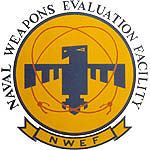 Doug Humbarger NRA Life member Tonkin Gulf Yacht Club 72'73. Yankee Station Try to look unimportant. Your enemy might be low on ammo. | |||
|
| one of us |
D Humbarger I am always ready Here is another picture that I took of the knife. The recurve grind in the back of the blade is for stripping wire and such. 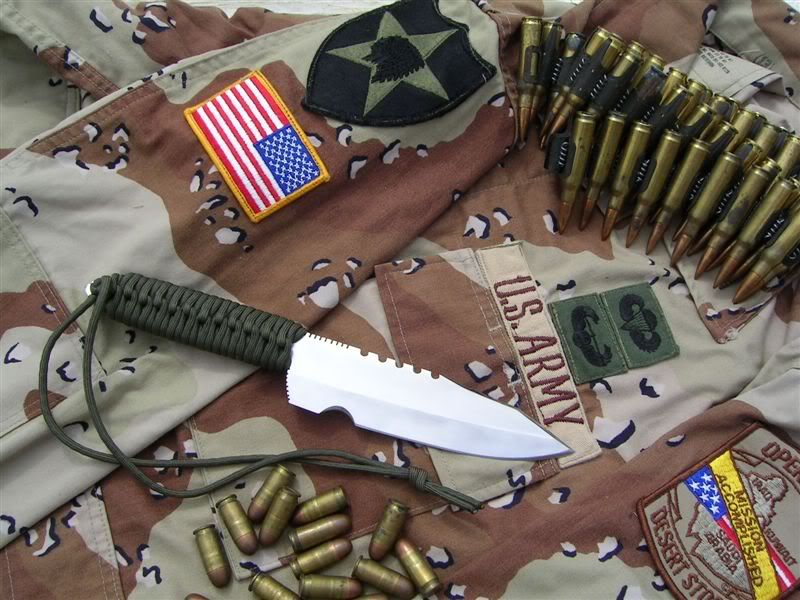 Cheers, André Always always use enough... GUN & KNIFE | |||
|
| one of us |
jaeger i have been invstigating duane dieter systems and im conclude with him tatally his method of mindset unarmed knife and guns in a full circle is near the perfection ,with several years of different martial arts most full contacts,soldiering,profesional hunting ,training i think i can evaluate a system and this is near the perfection.juan www.huntinginargentina.com.ar FULL PROFESSIONAL MEMBER OF IPHA INTERNATIONAL PROFESSIONAL HUNTERS ASOCIATION . DSC PROFESSIONAL MEMBER DRSS--SCI NRA IDPA IPSC-FAT -argentine shooting federation cred number2- | |||
|
| one of us |
Yes Juan Duane is the man when it comes to training military SF. Iposted this some time back but here it goes again for new readers: Duane P. Dieter - Official Trainer to the U.S. Navy SEALs This is his site http://www.cqd.net/  While reviewing M.O.D. knives for the last issue, I came across the name Duane Dieter on several knife models that M.O.D. produces. I told Jim Ray that I wanted to review the Mark I (a Duane Dieter model) and asked him about Duane's background. He told me that Duane taught the Navy SEALs, and that sparked my interest. Through my inquiry, I obtained some information/brochures that briefly describe CQD®. CQD® (Close Quarters Defense®) provides the specialized skills and training necessary to respond appropriately to both shooting and non-shooting situations and was established by Duane to provide realistic, effective instruction for police, military, security professionals and qualified civilians. His primary goal is to ensure operational readiness and skill sustainment, which is achieved through training in the six divisions of CQD, they are as follows: Direct Defense Skills, Weapon and Zone Control, Prisoner Control, CQD Shooting, Operational Physical Training, and Internal Warrior. The commentary below explores the multi-faceted layers of CQD, examines its distinct and effective tactical training skills, and discusses how these skills integrate in the training of U.S. Navy SEALs so the ability to be "Full Circle Ready™" in operations is achieved. The article we are about to present, "To Fight Is To Risk Death," is from the April 2003 issue of S.W.A.T. magazine; with S.W.A.T.'s permission, we present the article. TO FIGHT IS TO RISK DEATH Training SEALs to Be Complete Warriors By Bob Pilgrim Close Quarters Defense® Even from the relative safety of my "strap hanger's" position in the contested hallway, I can detect the shallow breathing and rivulets of sweat soaking their Nomex battle dress as two tense Navy SEALs prepare to enter their assigned room and capture a high value enemy leader. Utter silence prevails as they coil their bodies while they await the signal to launch the assault. They hope to accomplish the mission with complete surprise and by employing their newly acquired Close Quarters Defense® (CQD®) skills rather than having to resort to the use of their firepower. As part of a small, highly trained and conditioned raiding force that packs dual lethal and non-lethal punches far beyond their diminutive size, they fully appreciate combat's stark truism that to fight is to risk death. The eagerly awaited signal is silently received through their headsets; doors splinter and pandemonium reigns as a half dozen other teams carry out their orders. However, surprise is rarely complete and now speed dominates the contact's equation as commands to "get down on the floor" are interrupted by bursts of surgically directed semi-automatic fire from M-4 carbines and Sig 9mm pistols. Cautiously, I enter the nearest room after announcing, "coming in," to avoid the fate of those who gambled and lost. The scene before me typically reflected the controlled aggression and Full Circle of Defense™ skills and theories that the platoon had acquired during their initial instruction in CQD. The bodyguard was fast, but the SEAL was faster, as the former's training-round-stitched body attested. On the floor was his literally stunned leader, with one of the raiders heavily draped across his back applying a neck seal in preparation for flex cuffing, search, and extraction. What I witnessed in the Naval base's CQD Tac-House™ (realistic scenarios presented to test the operator and validate his skill) was CQD in action. Officially approved and adopted by the Navy in 1996, the CQD fighting system represents the culmination of a quest for a realistic hand-to-hand combat technique that was initiated shortly after World War II. The SEALs relentlessly searched for a fighting system that could provide operators with a spectrum of tactical responses, including non-lethal methods of control. After an eclectic study of and participation in a myriad of martial and fighting arts, it was determined that none of them were able to endure full contact, high speed, no holds barred aggression, particularly while in full battle dress. Since 1990, CQD's creator, Mr. Duane Dieter, who is headquartered in Easton, Maryland, had been instructing the Navy's elite on an extremely low profile basis. As more SEALs became exposed to CQD, they quickly realized that it offered a multiplicity of very powerful new techniques and training concepts. However, the most unique aspect of this new system is that it combined armed with unarmed combat and, most interestingly, character development into a single, stand-alone system. The Development of CQD® As Duane delved deeper into his martial studies, numerous contradictions occurred. Although he appreciated the skills he learned, he realized that many of these movements were more relevant to sport and choreographed competitions than to the high-risk fight initiated by a motivated adversary. Because of these contradictions, as well as several key events that occurred at that time, Duane founded a system that was based on high-risk engagement, with a just purpose. Each skill within the system was validated under the pressure of a motivated adversary. This system, CQD, is a totally integrated system for armed and unarmed defense utilizing shooting and non-shooting responses. After refining his system for nine years, Duane was given the opportunity to test the validity of CQD in field operations. In 1989 he was recruited by the Drug Enforcement Agency (DEA) as a member of the Organized Crime Drug Enforcement Task Force to fight the incursion of drugs into the Eastern Shore of Maryland. He was chosen for his tactical expertise as well as his knowledge of and stature in the community. During this time, he served on the DEA "Quick Response Team" as well as local SWAT and arrest teams. His primary responsibilities were raids, room entry, and apprehension of drug dealers. This provided him with field operational experience in the utilization of his CQD System. Basic CQD® Level I (L-I) CQD is taken by military, law enforcement and other government agencies, as well as individuals. Rank, particularly in the close-knit SEAL units, hath no privileges, and everyone gets thumped regardless of his position on a team and no one holds back. Every time a SEAL performs, whether it is operationally or in training, he is being evaluated by not only his leaders, but by his peers as well. Motivation, therefore, is unparalleled and although SEALs can be the most satisfying group of young men to teach and associate with, their expectations are exceptionally high. So, you had better have your act together, or you won't last any longer than it takes a shark to strike its prey. This attitude alone is mute testimony to CQD's success and its continued acceptance by the Navy as being the combat training of choice. Initially, CQD training was introduced in First, Second, and Third Phase at Basic Underwater Demolition School (BUD/S) and is now offered in a one-week format for SEAL Qualification Training (SQT), followed by another week for SEAL Operational Platoons. Complete Weapons Integration In the L-I course, with the exception of Simunitions use there is no live fire firearms training. Unique live fire training and drills are, however, included in more advanced CQD courses that have been taken by other classified SEAL groups. However, long and short guns are completely integrated into this basic curriculum and students are taught how to carry, retain, cover, handle and strike with them from various positions to stun and disable opponents prior to controlling them. Having been exposed to Dieter's CQD shooting techniques, let me just say that they are quite unlike anything most police and military personnel receive or experience during their careers. They are not fancy, nor are they derived from popular competitive shooting, or other shooting disciplines, but they are brutally effective and teach the SEAL to fully exploit both the "hot" and "cold" attributes of his weaponry. A Complete Fighting System Orientation to the course, its purpose, goals, and objectives and the development of the proper CQD mindset is instilled in the student at the outset. The instructors are handpicked veteran team members who have really been there and have really done that. If the new students haven't figured it out by now, they are reminded by Dieter's foundational training principle that "the truth of combat is - to fight is to risk death." This stark truism is kept foremost in the men's minds while undergoing these drills, and their innate will to survive and dominate anything that life or the enemy throws at them, provides supreme motivation to train, train, and train. CQD thoroughly embraces this cold concept and attempts to realistically simulate the risk of injury or death in the exercises. Since there are extreme risks attendant to all aspects of combat, CQD training must address them and does. All CQD techniques are "proven." To do less, as some training does, would be a disservice to the SEAL, the Navy and ultimately, the country. Surprisingly, however, injuries are few and most of them are what SEALs would consider minor and not mission defeating. They are by nature stoics and simply shrug off bangs, dings, scrapes, cuts, slams, and bruises that would debilitate the average person. Central to the system are weapon flows, hand positioning, and the Spring Stance. The Spring Stance, as its name implies, is very flexible. It provides a stable shooting platform, protects the lower body, and, above all, permits explosive reflex movements that support the CQD theory of "Attack the Attacker™", while exploiting every opportunity to win. Full Circle Of Defense™ Although L-I and higher-level physical and mental skills are taught incrementally, in an elemental fashion, they are completely integrated into the six divisions of the "Full Circle of Defense™." These skills, when fused to the warrior spirit and mindset, create the greatest human fighting capabilities. At the center of the "Circle" is the operator and he is closely surrounded by the six principles of CQD that he must be able to selectively or collectively call upon to dominate any combat situation. All are equal in importance and serve to integrate, and mutually support each other. They are, "Direct Defense Skills, Weapon and Zone Control, Prisoner Control, CQD Shooting, Operational Physical Training, and Internal Warrior." Specialized training concepts such as, "First Level of Defense, Weapons System, Tactics, Elements of Combat, and Engagement" follow this layer. The next area of training encompasses "Operational Readiness" and is augmented by the "Accountability/Sustainment Service." This consortium of defensive and offensive subject matter represents the massive amount of knowledge and skills that are passed on to the SEALs during this intensive five-day training cycle. Measured Use Of Force The SEALs are taught that philosophically, in CQD fighting, you do whatever it takes to win absolutely - to acquire every possible advantage to defeat your adversary. However, only the amount of energy and force necessary is expended and the practitioners never blatantly display power or employ actions that do not produce true, meaningful benefits. This method of fighting minimizes risk without jeopardizing the integrity and success of the engagement. Anytime force is used there will be repercussions and CQD employs only what is required to accomplish defensive goals. This reflexive, but measured response can be initiated either overtly or covertly depending on which method dictates the best chance for success. CQD® Principles The foundation of all levels of CQD training is "Direct Defense Skills" (DDS), which is the keystone, the first among equals of the five other principles in the Full Circle of Defense™. Operators are taught the most direct and effective methods of achieving their mission goals, whether in combat, or in life. It is literally the "art of efficiency". These skills create the knowledge, confidence and mental attitude, which enable the operator to respond to any situation with appropriate force. This may require the application of highly disciplined, rather than all out, force. However, this tailored response will still enable them to overcome even the most aggressive of assailants. Training here concentrates on the isolation and development of foundational skills, enhancing appropriate mind-body reflexes and the elimination of those that are deemed counter-productive. This specialized process develops the "Protective Reflex" which creates both offensive and defensive capabilities. Controlling all personal body weapons and their direct utilization against close quarters threats, coupled with greater degrees of efficiency is emphasized. L-I DDS develops the foundational unarmed skills that serve as the framework for subsequent armed skills. Focus initially is on the individual, on the operator himself, and the goal is to develop his primary fighting components of defense - "mind, body, and spirit." This approach creates a mindset for immediate situational threat evaluation followed by appropriate actions that employ the most efficient means/methods to succeed. Control Of Immediate Environment In Weapon and Zone Control, operators learn to retain and appreciate the inherent protective values of their weapons system. From threat detection, through weapons retention measures, to activation of shooting skills, the SEAL is trained to carry out his assigned responsibilities and control his zone of combat. Dynamic movement to gain tactical advantages is aligned with techniques to place prisoners in positions of maximum control to lead the SEAL to the third CQD principle of Prisoner Control. Abducting The Enemy The ability to pluck enemy personnel from the battlefield for pro-active intelligence purposes has been a SEAL specialty developed by the teams during the war in SE Asia. The "men with green faces" not only absconded with key Viet Cong infrastructure personnel, but frequently were able to do so, with his brethren snoring away in the next bunk situated within an enemy village hooch. These and other snatch operations are legendary and Dieter, through his CQD program has developed the art of prisoner capture and restraint to an even higher level of sophistication. In this block of instruction, operators are brought to fully respect their adversary's capabilities and appreciate the high level of skill that must be administered to maintain control over a prisoner without causing irreversible damage to this potential asset. The safe and effective control of compliant and non-compliant combatants through the "approach, contact, control, movement, extraction, and transfer phases" is individually and collectively drilled. Operators develop the confidence to use their skills, whether standing, fighting on the ground, or in vehicles or confined spaces, while still retaining the last resort option of their weapons system. Weapons Handling In L-I CQD, operators are schooled in the "low, middle and high power point" ready gun positions, as well as "extended on line and off line" cover or support stances. These as well as esoteric sounding "wing guard" and "fire hand" security positions are practiced while static and on the move. They, and numerous other skills, allow the operator to respond instantly with deadly force at both close and extended ranges, or to use his weapons to "intimidate, destabilize, stun, immobilize, injure (non-vital or vital) or incapacitate." Like the police officer, the SEAL now has a spectrum of responses to choose from in order to comply with the mission profile or fit the evolving situation. The SEALs are reminded that not just accuracy, but surgical shooting may be necessary at any distance and under extreme conditions. "Observation, threat assessment and evaluation of the situation" must precede activation of their weapons. CQD Physical Conditioning The public is justifiably confident that the SEALs are in superb physical condition. However, to enable them to execute the skills attributed to CQD properly and forcefully, a good deal of Operational Physical Training™ (OPT™) must be conducted. OPT is designed to accomplish a multiplicity of physical goals. Physical capabilities are enhanced to prevent injuries, to both isolate and coordinate CQD's unique skills and to gain total body control. OPT also incorporates mental and physical levels of training and encourages the development of physical prowess. Internal Warrior™ Training In the softer sectors of society the term "warrior" often engenders negative connotations. However, today's SEAL is a blend of the traditional and historical American man of war and a more modern warrior, that not only maintains the best fighting attributes of his forbearers, but at the same time can readily adapt to the military requirements of a changing world. Although Internal Warrior training is the last CQD principle discussed in this article, its theme constantly permeates every facet of the program. Dieter impresses upon these young men that the greater their purpose, the greater their fighting potential will be. He requires that their commitment to the fight "goes far beyond their personal defense and should be predicated on the purpose of defending and protecting their country and its citizens." True warriors want to engage in justified battles and this desire to fight for what is right is not confined only to the combat zone, but also extends into everyday life. CQD is also about developing good character. The SEALs who attend this training are encouraged to do what is right in life's daily struggles in the belief that this personal example and behavior fosters the same strengths required by combat. Embracing the philosophy of "if it doesn't kill you, it makes you stronger," similarly, disappointments and setbacks experienced by these SEALs serve to augment their personal growth, perseverance and desire to be the best at who they are and what they do. All things being equal, the difference between a good warrior and a superior one is possessing a positive attitude that enables one to believe in himself and ensures the ability to continue to achieve under the conditions of life's most intense struggles. This attitude also assists in knowing and assessing himself, his strengths, weaknesses and how to evolve beyond them. Mutual Support = Mutual Success Teammates support and pull together for each other. Although down time is rare, I observed individual SEALs with their swim/dive buddy critiquing their performance and chastising themselves internally if it wasn't up to standard. Negativism and self doubt is not permitted to persist and SEALs encourage each other to always think in positive terms and of overcoming any obstacle. They learn that this internal skill is the true edge in combat. Mission success relies on the team, but the team relies on the mindset of the Internal Warrior and resulting strong individual performances by each operator. The most dynamic effect of Internal Warrior training gives the operator the strength to fight through the high anxiety of battle, to stop the threat. In CQD training, students are held accountable for their actions and the influence they have on others. Conversely, they are cautioned not to allow negative personalities to affect their strength and determination or undermine the spirit of a fighting unit. They are taught that negativity is tantamount to weakness and it must never be given a chance to rule. In this 40-hour block of instruction the SEALs are admonished to appreciate all those who have been instrumental in their development and to encourage teammates to do well, because the success of others is also their success. The greatest level of appreciation for their fellow warriors is developed during the heat of battle; closest possible bonds are created and any barriers that may have existed crumble in the face of mutual danger. Tactical Infractions Individuals are cautioned that their reasons for activating CQD skills must be clear. To enter a conflict with an improper attitude and initiate a fight gratuitously, without a justifiable purpose, is considered a "tactical infraction" and cannot be condoned. The simple goal of Internal Warrior™ training is that when a person employs his CQD skills against an adversary he should never regret having done so. Dieter and his veteran instructors often surprise their students by telling them that true warriors are also kind, compassionate, and dedicated to helping others. This gentler aspect of the warrior will however, never diminish his ability to be the most aggressive in battle. The Complete Warrior The ultimate objective of this fighting system, as the reader may have gathered by now, is to develop the complete warrior - one who succeeds in life as well as in battle. This noble concept goes far beyond the training I received as an infantry Marine, which was simply to find and fix the enemy, destroy him and his will to fight. There is certainly plenty of room for that strategy today, but like it or not, the military, particularly special warfare entities like the SEALs, are, and will be, employed in perhaps non-traditional missions, which will require a stiletto and not the broad sword. High Praise On October 6, 1999, a change of command ceremony was held at the SEAL base in Coronado, California. Rear Admiral Eric Olson praised Captain Joe Maguire, the outgoing Commanding Officer of Naval Special Warfare Center for his leadership and many accomplishments, including the establishment of the CQD program. Captain Maguire in his remarks, "regretted that he did not have CQD training available to him when he was a younger SEAL" and said it would have "made a tremendous difference in his preparations for, and resulting confidence to engage in, combat." For the past twelve years CQD has succeeded on its merit and has provided NSW with unique fighting capabilities. Are You Ready? For those of you reading this article and who possess tremendous pride in yourselves, relish difficult challenges, have good will, are persistent, physically and mentally strong and above all love and want to serve your country, consider joining the U.S. Navy and becoming the best this nation has, a U.S. Navy SEAL. For more information, visit their recruiting web site at: www.sealchallenge.navy.mil. Parallel to Dieter's military training are personal and operational "readiness" courses, as well as instructor courses that he developed specifically for all levels of law enforcement and security professionals. For information, contact CQD at (410) 822-0451 or cqd@goeaston.net This is the site http://www.realfighting.com/0503/ddieterframe.html Cheers, André Always always use enough... GUN & KNIFE | |||
|
| One of Us |
Nice post, I am a Navy Parachute Rigger and a good mate of mine was an Armorer at BUDS from 1999-2003 October. He said it was the best job he ever had. He wasn't a SEAL he was support. | |||
|
one of us |
André, very nice! Who needs a need... And anything is better than making sushi if you asks me... Have not seen you over on the Africa forum for a while, I hope everything is well with you family? Regards, Martin ----------------------- A man can never have too much red wine, too many books, or too much ammunition. - R. Kipling | |||
|
| one of us |
Martin Alt er bra. I am very busy with law school and don't have much time to post and chat in the Big bore or African forum. I do however have time to post in the knife section LOL God jul min ven PS This is my new hunting knife made by Jimmy Lile #3-5 and the English tweed shooting suit. I know you aprove LOL 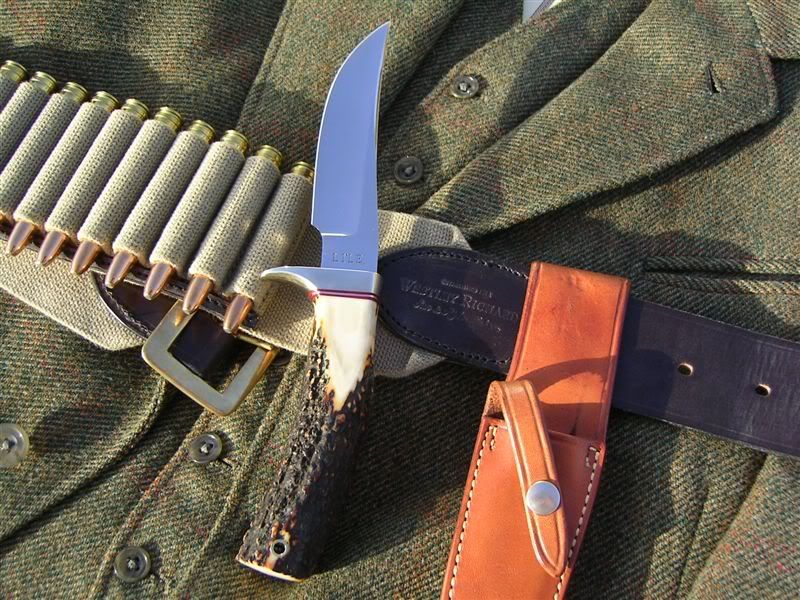 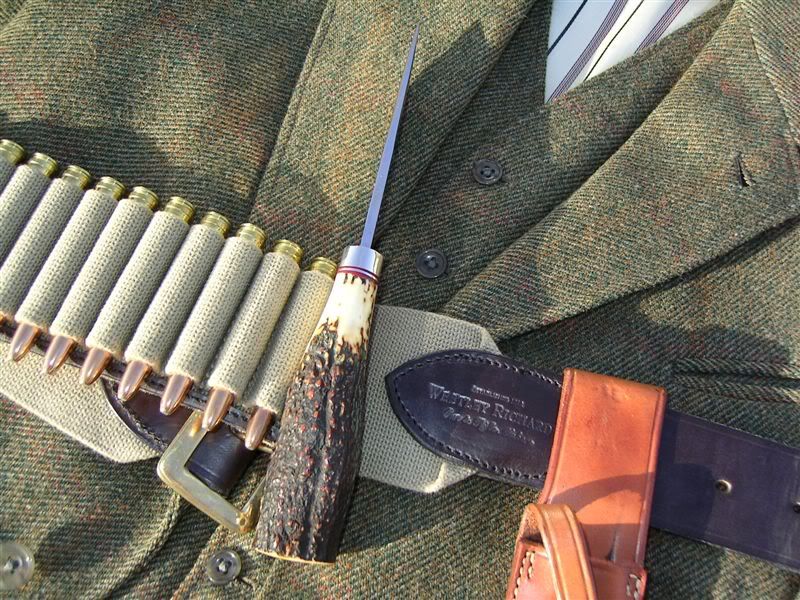 Always always use enough... GUN & KNIFE | |||
|
one of us |
God Jul Andre! I am glad to hear that everything is fine, I hope to see you here in Sweden in the spring, at the Big Bore meeting. The three-piece tweed suite looks really nice and made for serious work in the field. As to knives, I am at the moment very tempted to buy a knife from Gene Ingram. Regards, Martin ----------------------- A man can never have too much red wine, too many books, or too much ammunition. - R. Kipling | |||
|
| one of us |
Martin I will try to make it this year - this time I don't have a baby on the way. The knives of Gene Ingram are very nice and owning one would make you happier.  Always always use enough... GUN & KNIFE | |||
|
one of us |
Yes, a very nice knife! I was talking about dates for the bigbore meeting with cchunter the other day, hopefully he will settle on a date soon. I will defend my PhD-thesis around that time, but hopefully I will be able to shoot some heavy rifles as well. Regards, Martin ----------------------- A man can never have too much red wine, too many books, or too much ammunition. - R. Kipling | |||
|
| one of us |
Im testing a boar spear that Steve Thorsen gave me ,its wonderful for killing but is very dangerous for dogs so i prefer my clients use knives .If you are training hunters i would recommend an applegate smatchet ,remember them that they must run in corn fields ,water etc .juan www.huntinginargentina.com.ar FULL PROFESSIONAL MEMBER OF IPHA INTERNATIONAL PROFESSIONAL HUNTERS ASOCIATION . DSC PROFESSIONAL MEMBER DRSS--SCI NRA IDPA IPSC-FAT -argentine shooting federation cred number2- | |||
|
| Powered by Social Strata |
| Please Wait. Your request is being processed... |
|

Visit our on-line store for AR Memorabilia

